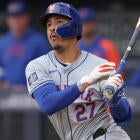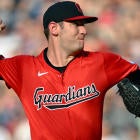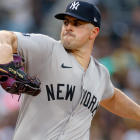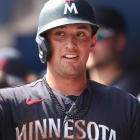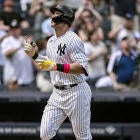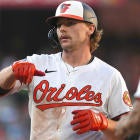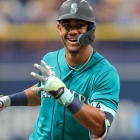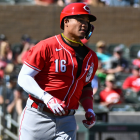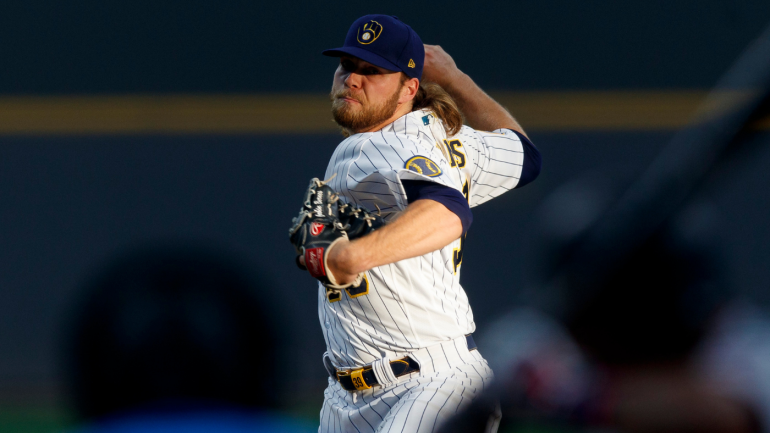
We're seeing some historic performances on the pitching side of things so far this MLB season. Shane Bieber has a stunning 35 strikeouts in 21.1 innings over his first three starts, and while Corbin Burnes can't quite match Bieber strikeout for strikeout, he did become the first pitcher since 1906 with 30 strikeouts and zero walks through his first three starts of a season. And, of course, we watched Joe Musgrove throw the very first no-hitter in Padres history last weekend.
These individual performances have been incredible, but they aren't happening in a vacuum. At least through the first couple of weeks, we're seeing an offensive environment in Major League Baseball that seems tilted extremely strongly toward pitchers. I went over some early surprising stats from the hitting side Wednesday, mostly focusing on some outlier performances by individuals. I've got some of those for the pitching side, too, but you can't talk about them without putting them into proper context.
Here are 10 surprising pitching stats to know about, beginning with some dramatic changes to the offensive environment going on:
- The league-wide strikeout rate is up to a record high -- again
As I talked about in my "10 surprising hitter stats" column, the new ball in play in 2021 has had plenty of impact already, but the biggest impact has been on strikeouts. The league-wide strikeout rate is up to 24.7% entering play Wednesday, up from 23.4%, the previous high-water mark. And, lest you think that's just because pitchers are batting again, there's this:
FWIW, while this explains *some* of the new record-high MLB strikeout rate, non-pitchers are still striking out 24.0% of the time, UP from 23.4% in 2020 and 22.4% in 2019. https://t.co/50l5KhRdtS
— Chris Paul Towers (@CTowersCBS) April 14, 2021
Even if you remove pitchers from the equation, hitters are striking out more than ever this season. How does a different ball impact strikeout rate? Well, according to this piece from The Ringer from spring training, the new ball exhibits signs of having more drag, in addition to being a little bit lighter. That seems to be a result of slightly higher seams on the ball, something pitchers have commented on dating back to early in spring training. The combination of pitchers having better grips and pitches having more movement due to increased drag seems like an obvious candidate to explain why strikeouts are up.
That's something to keep in mind when you are trying to figure out which pitchers to buy in on and who to chase on waivers. Starting pitchers are averaging 5.04 innings per start and 5.18 strikeouts -- for the first time ever, starters are averaging more than a strikeout per inning. Those pitchers who don't get strikeouts are increasingly setting you back, while those high-volume aces could potentially be even more valuable than ever.
2. Average fastball velocity is up -- again
The averaged four-seam fastball has been thrown 93.4 mph this season, up from 2020's already record-high 93.1 mph. And it's even more impressive when you compare it to April of 2019. That season, the average fastball velocity for the league as a whole at the end of the season was 93.1 mph, but it was 92.9 in April. That's another reason strikeouts are up and offense in general is down.
3. BABIP is down too
At the risk of oversimplifying, there are three key components that go into batting average: Strikeout rate, home run rate, and batting average on balls in play. Strikeout and home run rates are the parts pitchers and hitters generally have the most control over, while BABIP tends to fluctuate quite a bit from player to player and year to year, but has generally settled in the .295 to .300 range leaguewide over the last couple of decades. Last season, however, that mark fell to .292, the lowest it has been since 1992.
Entering play Wednesday, league BABIP is down to .287. Add in the record-high strikeout rate and the lowest home run to flyball rate since 2018, and it's not hard to see why batting average is down. However, it's worth highlighting how low it is -- .234, the lowest in MLB history, three points lower than 1968, the famed Year of the Pitcher.
We're talking about small sample sizes all around here, again, but the sample for the league is actually 12,097 plate appearances, so there may not be that much noise here. BABIP does tend to increase as the season goes on -- over the last five seasons, MLB BABIP was .052 points lower in April than the season as a whole -- so we may not see that average record be broken, but the fact that it even looks possible highlights how much the offensive environment seemingly has changed. This time, seemingly to the benefit of the pitchers.
4. 51 pitchers have a save
And only 29 teams have a save right now. Looking around baseball, I think you can be pretty confident about who is going to get the next save for most teams, but already we've seen potential changes in Baltimore, Toronto, Kansas City, Texas, Oakland, Miami, Cincinnati, and Arizona within the first couple of weeks. What's been the impact of that on Fantasy leagues so far? Well, there have been 2,194 saves recorded in 43 NFC Main Event leagues (15-team Roto), which comes out to 51.02 saves per league. There have been 78 saves in MLB so far, which means 65.4% of them have been rostered and active -- that number was 70.5% in 2019, per Rob Silver. And these are 15-team leagues, where the odd save by a Corey Knebel or Nick Wittgren is more likely to be in your lineup than in a more standardized 12-team league. Saves are harder to find than ever this season.
5. Trevor Rogers -- Second-highest swinging strike rate
Rogers showed promise as a rookie, but now he's showing ace potential. His fastball velocity is up to 95.5 mph from 93.6 in 2020, and he's picking up a ton of swinging strikes with the pitch -- it's actually been his primary putaway pitch so far. However, he's also got a 50% whiff rate on his slider and a 29.4% rate on his changeup, both of which are very good marks, even in a small sample. There are some warning signs in his profile -- when he does give up contact, it has tended to be hit hard, and his walk rate is up to 15%, though that was mostly just one bad inning in his first start -- but all in all, Rogers is showcasing elite stuff right now. I've moved him all the way up to 47th at starting pitcher, and he could continue to be a very fast riser if he keeps this up.
6. Corbin Burnes -- Throwing his cutter 50% of the time
I'm sure it's easier said than done, but I'd like to see more pitchers try to follow Burnes' lead here. No other pitcher has a cutter they can throw 98 mph and command, of course, but there's always going to be value in trading fastballs for a better pitch -- in 2020, four-seam fastballs allowed a .358 xwOBA for all pitchers, and sinkers/two-seam fastballs allowed a .360 xwOBA, while all other pitches allowed a .285 xwOBA. I don't think those numbers would remain static if every pitcher threw their best secondary pitch 50% of the time the way most throw their fastballs, but it's something more pitchers should consider experimenting with.
7. Walker Buehler -- Second-lowest swinging strike rate among qualifiers
It's interesting, I was starting to get a little more excited about Buehler toward the end of spring training because he seemed a lot more stretch out than in past years, and he's already thrown 90-plus pitches in both of his starts so far, something it took him until his fourth start to do last season. However, his fastball velocity is down 1.7 mph from last season as well, and he's thrown it 69.4% of the time in those two starts. So, he's not following Burnes' example, I guess. It's too early to be panicked about Buehler, obviously, and he actually might be following new teammate Trevor Bauer's example here -- Buehler's fastball spin rate is up despite his diminished velocity, a trick Bauer pulled off last season, to his benefit. We'll see what it means for Buehler going forward, but so far, I don't exactly love what we're seeing from him.
8. Alex Cobb -- Fourth-highest swinging strike rate
"The Thing" is back, and Cobb actually does seem to be pulling off a similar trick to Burnes. It's only two starts, but he's throwing his splitter more than ever -- 45.4% of the time so far, in fact. It's historically been his best pitch and the early returns on this change in his approach are extremely promising, as he's picked up 13 of his 17 strikeouts with the pitch. He hasn't quite made it his primary pitch, despite what the overall usage rate indicates -- he's used it just 12.2% of the time in 0-0 counts, instead opting to throw his sinker or curveball in those situations, though with an overall decrease in his sinker usage in those counts as well. It's fair to be skeptical of Cobb, given how his last few seasons have gone, but with 17 strikeouts to just two walks in 11.2 innings, you shouldn't be ignoring him.
9. Matthew Boyd -- Yet to allow a home run
Based on how the last couple of seasons have gone, going even one start without allowing a homer is a pretty big deal for Boyd -- he only had three starts out of 12 without a homer allowed in 2020, and he only had 11 in 32 starts in 2019. He hasn't gone multiple starts without allowing a homer since his final two starts of May 2019, and he hasn't gone three since his first three starts of 2019. That season started off with 29 strikeouts in his first three starts, compared to just 14 so far, so Boyd is certainly going about things in a different way in that regard, too. His groundball rate isn't higher, so maybe this is just a fluke, though Boyd has already induced seven infield flyballs after having just five all last season, so that's one way to keep homers off the board. He's throwing his fastball less often than ever while increasing both his slider and changeup usage, so there are tangible changes here. Whether they can keep him pitching well is a different question, of course -- and it's one I tend to think won't work out in Boyd's favor.
10. Luis Castillo -- Has lost 1.8 mph off his fastball
Castillo's Opening Day start was especially concerning, as he averaged below 95 mph with his fastball, but even the last two have been about 1.5 mph down from his 2020 average. It could just be a short-term trend -- his velocity was also on the 95-95.5 mph range in his first three starts in 2019 -- but given that it's accompanied by a steep decline in strikeout rate and a bunch of hard-hit balls, it's at least worth mentioning. Castillo isn't just getting unlucky right now; he needs to pitch better.









